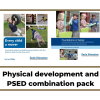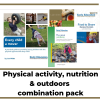Outdoors and Active
Outdoors and Active – an action research project commissioned by the London Borough of Newham – took practitioners from nurseries, schools, PVI settings and children’s
Even everyday journeys and mundane chores can be used to encourage children to be more physically active. Here are some ideas, suggested by the Outdoors and Active project team:
To get an printable copy of these ideas to take with you, download these Top Tips for Everyday Physicality
Outdoors and Active also generated a list of great suggestions for a physicality Grab and Go Kit – you can view and download the list on our Grab and Go Kit page.
Outdoors and Active – an action research project commissioned by the London Borough of Newham – took practitioners from nurseries, schools, PVI settings and children’s
Busy modern lives are having a dramatic impact on the health and wellbeing of our youngest children. They play outdoors less, spend more time being
Little or no equipment is needed to get children active in the park – not even the play equipment that’s probably already there! If there is play
Toddlers need plenty of balance practice once they are up and walking. Each of the three semi-circular canals in the inner ear respond to movement in different
An early task for the Outdoors and Active action researchers was to identify the barriers to taking children out and about beyond the setting. Only
Human beings are “hardwired” to take risks, from birth. Babies take their first independent breaths; they decide to try crawling and walking and then running;
Traditional fixed play equipment is not necessary for physicality; if it’s there, then great – use it. Most of the Outdoors and Active project settings
Children can have fun and be active in any kind of landscape, but there’s no doubt that the more diverse and intriguing the space, the
To audit the current provision for physical development outdoors in your school or setting, you can download our three sample audit sheets below. You should
Are children at your setting moving enough? Do they enjoy plenty of physically active outdoor play? The Newham Outdoors and Active practitioners spent eight months
Some of the childminders involved in the Outdoors and Active project thought that a kit of easy to carry, low cost resources could encourage children









Early Education
2 Victoria Square
St Albans
AL1 3TF
T: 01727 884925
E: office@early-education.org.uk